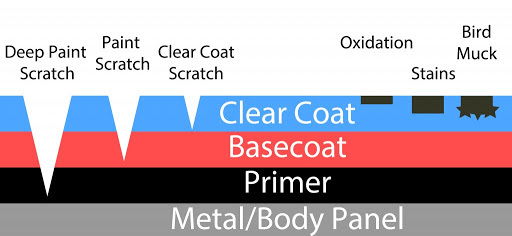Paintwork issues- Swirls, scratches and holograms
Your cars paintwork is subjected to daily abuse. UV rays, wind, rain, mud, dirt, bird droppings, and scratches, to name just a few. Those who have maintained a protective layer on their paintwork, by having had it waxed or sealant or ceramic coated, are less likely to find paint problems, but the truth is that poor washing technique, or even touching or rubbing your paint without any form of liquid on the surface can introduce marks.
If you're lucky, damage may be limited to just the top surface only. In the case of light scratches it is likely only the top clearcoat has been marked and the scratches may well polish out. If the scratch is deep enough to run a fingernail into, then it has penetrated the topcoat and will require filling and repainting.
Bird droppings are acidic, and if allowed to sit for any extended length of time they can cause etching in the paint, so if you see droppings on your car remove them quickly, but ensure you use water, and allow the cloth you are using to soak first before gently wiping off.
To illustrate the make up of your paintwork, this diagram shows the levels of coatings on your vehicle. When you wax or polish you are not directly polishing the paint but the top coat, unless you have a very early generation vehicle which has a two stage paint and not a clear coat.

SWIRLS- Poor washing technique can cause swirls to appear in the paintwork. Traditional washing methods involved using a bucket, sponge and shampoo. This is a massively flawed technique as a sponge absorbs everything, and the dirt you removed with the sponge before dunking it into the shampoo filled bucket to wipe again, is merely putting that dirt back onto the paint, and since most people use a circular motion to wash, swirl or starburst patterns can appear in the paintwork. Initially these may appear as being very small, and may only be really visible when your eye catches the suns reflection in the paint as you move. If these marks are small they can perhaps be polished out with just a single stage polish.
If you look into the spot where the sun is shining in the paintwork, the swirls or starbursts look like cobwebs emanating out from that bright central spot.

SCRATCHES- Where swirls or scratches are deeper, then a second stage polishing may be required. This stage uses a cutting polish and pad to go deeper into the top coat. Concious of the depth of the clear coat, the detailer needs to ensure he doesn't cut too deep and not leave enough clear coat on the paint. Using a cutting compound polish and pad can remove marks, but as it does this it actually removes a little of the shine in the top coat, which then requires another pass with a lighter polish and pad to buff it back to its optimum finish and gloss.
The first picture shows scratches on the bonnet of a Jaguar X-Type caused by cleaning it with a kitchen scourer. The second was caused by branches rubbing along the complete length of the vehicle. As you can see in this picture and the linked film, the whole vehicle polished back to as new, much to the customers delight.
Check the films section in the image gallery to see how the scratches were fully removed and the vehicle returned to a beautiful unmarked condition.


HOLOGRAMS- as illustrated in this picture, are the effect of poor polishing technique. If too much pressure is applied to the pad as it is moved across the surface and too much heat builds, it can leave trails behind. These are clearly visible in the paintwork, and as you move, these trail marks appear to move and change shape too, hence the name hologram. These can be polished out carefully using a finishing compound polish.

OXIDISATION- If your car paintwork looks like this, it's time to visit a bodyshop or sand and repaint. This condition comes as a result of insufficient protection of the paint over an extended period, and the coating effectively giving up.

AutoMOTO Detail can advise on the best protection for your paintwork after discussing your requirements and projected maintenance.